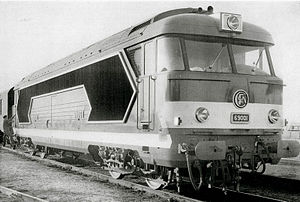SNCF BB 69000
| BB 69000 | |
|---|---|
|
BB 69001
|
|
| Numbering: | 69001-69002 |
| Number: | 2 |
| Manufacturer: | SFAC |
| Year of construction (s): | 1963-1964 |
| Retirement: | 1984 |
| Axis formula : | B'B ' |
| Gauge : | 1435 mm ( standard gauge ) |
| Length over buffers: | 19,000 mm |
| Height: | 4280 mm |
| Width: | 2972 mm |
| Trunnion Distance: | 11,200 mm |
| Bogie axle base: | 2400 mm |
| Total wheelbase: | 13,600 mm |
| Service mass: | 83.8 t |
| Friction mass: | 83.8 t |
| Wheel set mass : | 21 t |
| Top speed: | 140 km / h |
| Installed capacity: | 2 × 1520 kW (2 × 2065 PS) |
| Starting tractive effort: | 430 kN |
| Wheel diameter: | 1250 mm |
| Motor type: | SEMT Pielstick 16 PA 4 185 |
| Motor type: | 2 × 16 cylinder four-stroke diesel engine |
| Rated speed: | 1565 / min |
| Power transmission: | hydrodynamic |
| Tank capacity: | 4500 l |
| Brake: |
indirect air brake direct air brake hand brake |
| Train control : | SNCF |
| Coupling type: | UIC screw coupling |
The hydrodynamically powered locomotives of the BB 69000 series were built in 1964 for the French state railway Société nationale des chemins de fer français (SNCF). With an output of 2 × 1520 kW, they are considered the most powerful diesel-hydraulic locomotives in the world.
Like the CC 70000 , they were test locomotives to replace the most powerful steam locomotives of the SNCF around 1964. In contrast to the already existing diesel locomotives , these machines had two drive motors and a hydrodynamic drive. They were retired in 1984 and scrapped in the late 1980s.
History and description
Parallel to the development work on the BB 67000 , A1A A1A 68000 and CC 70000 with diesel-electric drive , the SNCF had Schneider Electric (SFAC) develop a locomotive with hydrodynamic power transmission and build two model locomotives for test purposes from 1961. In contrast to the SNCF, the Deutsche Bundesbahn had procured diesel-hydraulically driven mainline locomotives with the twin-engine V 200 since 1953, which proved to be more efficient and - due to the lack of electric traction motors and generators - to be lighter. The diesel train promotion department of SNCF, MTE and Voith-Getriebe KG were called in to help develop the locomotives .
Thought were the locomotives for the transport of the heaviest trains on catenary-free routes to the steam engines - especially the 241 P - to replace. After scheduled and unscheduled stops, they should have the same acceleration capabilities as electric locomotives . The consistent lightweight construction in the design of the vehicle parts, the power transmission and other assemblies resulted in a locomotive design whose specific performance parameters exceeded all diesel-hydraulic locomotive designs at the time of construction. Since the two Pielstick - Diesel engines of the type 16 PA 4 per nearly t weighed 15 were dispensed with the installation of a steam generator for the train heating system and a handle, if necessary Heizwagen back. The side walls of the locomotives were beaded, and the fronts and doors were made of multi-layer polyester . Despite its 2 m longer length, the locomotive body of the BB 69000 was 800 kg lighter than that of the BB 67000. In contrast to the German V 200, the gearboxes rested directly on the bogies . While the gearboxes were designed for an output of 2400 hp at 1565 / min, the engines were initially set to only 2060 hp at 1510 / min. The possible total output of 4800 hp was never used in commercial operation.
After delivery, the two Chalindrey- based machines were tested for several years from 1964. Instead of them, however, the CC 72000 series was put into series production from 1972 . Like the two CC 70000, the BB 69000 continued to be used for freight train service. A single machine system on the CC 72000 was the decisive advantage over the twin-engine BB 69000. The beginning of the oil price crisis was the decisive reason to take the locomotives out of service. Because of the high maintenance costs , the locomotives were retired in 1984 and scrapped in the late 1980s.
The design of the locomotives, which are based on the BB 67000 on the outside, was created by Paul Arzens . The two arrows on the side faces, pointing in opposite directions, symbolized the presence of two motors.
literature
- Wolfgang Glatte, Lothar Reinhardt: Diesel Locomotive Archive , Transpress-Verlag, Berlin 1970
Web links
Individual evidence
- ↑ a b c d e f BB 69000, CC 70000, CC 72075. Les espoirs déçus du diesel in: Ferrovissime No. 106, p. 28 ff.
- ↑ a b BB 69000 SNCF at trains-europe.fr, accessed on 10 August 2020
- ^ Wolfgang Glatte, Lothar Reinhardt: Diesellok-Archiv , Transpress-Verlag, Berlin 1970, description of the BB 69000
- ↑ La ligne 4 - bastion de la vapeur et des protos diesel in: Ferrovissime No. 91, p. 20 ff.
